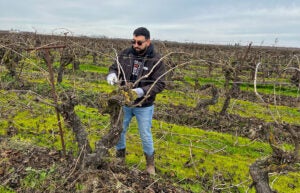Most people can agree that the 2023-24 winter has been warmer than most. It was predicted that this winter would be warmer due to El Niño, which is a periodic warming of parts of the Pacific Ocean. This changes weather patterns and increases temperatures globally. So far, much of the country (and especially the upper Midwest) has experienced one of the warmest winters on record. This also means low ice coverage on lakes and low snow totals across the country.
This warmer winter might be nice to experience in the moment, but it also has a big impact on agriculture.
Here are some of the ways warmer winter can affect agriculture.
Warmer weather can bring out insects earlier. In Minnesota, deer ticks have already made their presence known. Deer ticks are the tick species that carries Lyme disease and many other illnesses. Lyme disease is most likely to affect people and animals who are outside more often, which tends to include agricultural workers. Other insects that have a more direct impact on crops and livestock are also more likely to make an early appearance when the weather is warmer. Some insects and parasites could also survive more easily over winters. This could also mean an increase in the use of pesticides and parasiticides for crops and livestock.

Plants also enter dormancy in winter due to both day length and temperature. Plants can experience cold damage if temperatures are too warm and they start to de-acclimate from dormancy too early. This isn’t a problem for most crop farmers, but a warmer winter could cause major trouble for those who have fruit trees and vineyards. If a plant or tree already has buds and there is a late-spring freeze, there can be major impacts on fruit crops. For example, temperatures of 28 degrees Fahrenheit will result in about a 10 percent flower loss and 24 Fahrenheit will result in a 90 percent flower loss.
Problems can also arise when pruning, especially in fruit crops. Many types of fruit trees and grape vines are pruned when the plant is still dormant. Pruning when the plant or tree is dormant allows the cut to heal faster, keeps fungal spores at bay (many need a temperature above 50 degrees to be active), and lessens the chance of a bacterial disease entering the cut. If you prune too late, it is more likely that you will run into problems with diseases and fungal pathogens.

Warmer weather means that any moisture that falls is more likely to fall as rain instead of snow. This can cause muddy conditions for both farmers and ranchers. This can even increase the likelihood of soil compaction, which can have a big impact on crops.
A lack of snow from a warmer winter can also cause some issues, especially in places where there were already drought conditions entering into winter. Snow adds moisture back into soil and replenishes groundwater. It also protects cover crops and reduces erosion while preserving nutrients in the soil. Places that may have received less snow than normal will likely be fine as long as they received rain this winter or in late fall.
A warmer winter can also greatly affect fish farming. Warmer temperatures cause fish species to shift northward. Species moving north could put them into competition with other species. Higher water temperatures can also increase marine disease outbreaks. Changing temperature and seasons also affect the timing of reproduction and migration for many aquatic species. Many steps within an aquatic animal’s life cycle are controlled by temperature and changing seasons. For example, warmer water temperatures can affect the lifecycle of salmon and increase the likelihood of disease.

Warmer winters can also have their benefits. Farmers could start planting sooner, which would give their crops more time to grow and mature, possibly increasing yields. Increases in temperatures can also increase crop yields in some places, but only if nutrient levels, soil moisture, water availability, and other specific conditions are met.
It’s important to remember that it’s still early. In many places across the country, the weather can change quickly and there’s still lots of time for the temperatures to turn cold. A warmer winter can benefit farmers by giving them an earlier planting season, but it can also bring insects out earlier, increase the chances of bacterial diseases affecting plants, increase soil compaction, and have other impacts on animals, crops, and the people who rely on agriculture for their livelihood.
Michelle Miller, the “Farm Babe,” is an internationally recognized keynote speaker, writer, and social media influencer and travels full time to advocate for agriculture. She comes from an Iowa-based row crop and livestock farming background and now resides on a timber farm in North Central Florida.



